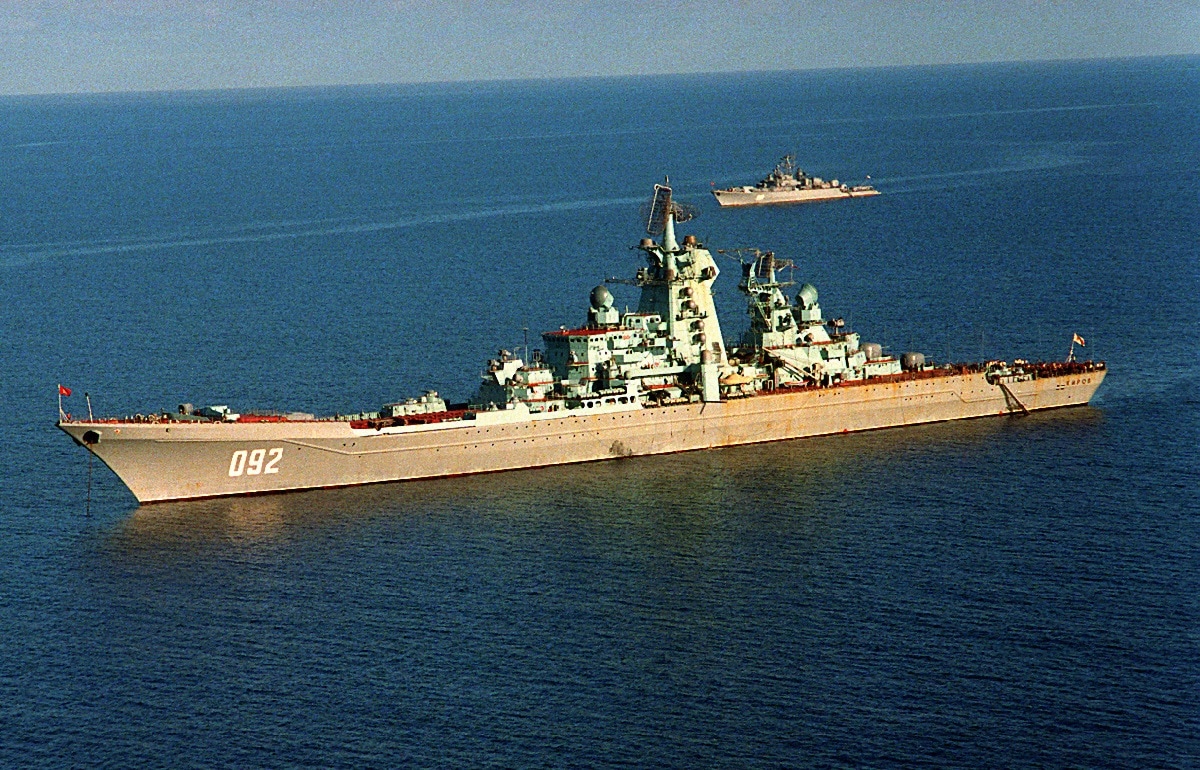One of Russia’s Giant Battlecruisers Is Ready for War: Can Russia’s two existing battlecruisers enter the fight against Ukraine? The Kirov-class battlecruisers are some of the biggest warships in the world if you don’t count aircraft carriers. One of the 827-foot vessels is still in the shipyard for renovations and is out of the mix. But the other nuclear-powered ship just completed exercises in the Barents Sea and is one asset the Russians could choose for deployment to the Black Sea for action off the coast of Ukraine.
No Battlecruiser in the Black Sea Yet
So far, a scouring of open-source intelligence found no reports of the Kirov-class battlecruiser Pyotr Velikiy in the Black Sea for the Ukraine theater of operations. The Russian Navy reportedly has 21 ships in the Black Sea as of March 22. Twelve of these are surface fleet vessels and nine are amphibious landing ships. The Moskva, one of the Slava-class missile cruisers, is in the Black Sea and this is thought to be the biggest ship operating near Ukraine.
One Battlecruiser Is Still Docked for Re-fit
The Pyotr Velikiy, of the Northern Fleet, completed drills in the Barents Sea last month. The other Kirov-class battlecruiser – the Cold War-era Admiral Nakhimov, is in re-fit for weapons upgrade and nuclear refueling. The Russian navy has substantial plans for the 35-year-old Admiral Nakhimov that is laid up in Sevmash shipyard in Severodvinsk. The $1 billion renovations will include new missiles, a close-in weapons system, new electronics, anti-submarine munitions, long-range surface-to-air missiles, and perhaps even hypersonic missiles.
But the Armaments Will Be Substantial Upon Completion
The Admiral Nakhimov will get the modern Fort M missiles for a ship-borne S-300FM SAM system. The S-300FM can take on six targets at once and be effective against anti-ship missiles from up to 93-miles away. The battlecruiser may also eventually receive an S-400 SAM system.
The Nakhimov already has Oniks anti-ship cruise missiles and Kalibr land-attack cruise missiles. The Tsirkon hypersonic missile may also make a cameo on the ship at some point. The 28,000 ton ship can also carry three helicopters.

A starboard bow view of the Soviet Kirov class nuclear-powered guided missile cruiser KALININ.

A port view of the Soviet nuclear-powered guided missile cruiser KIROV at anchor. In the background is a Soviet Krivak I-class guided missile frigate.
But not so fast. The Nakhimov, like many ships that are serviced by the Russia’s naval shipyards, has endured a schedule slip and won’t be ready until next year.
Engines Are An Issue
“The main problem with the Admiral Nakhimov as well as with all the Orlan project cruisers—four built, two of them retired—is the nuclear-powered engines, which use highly enriched uranium,” said naval analyst Pavel Luzin who was interviewed in Forbes. Luzin also explained how the engine machinery is from the 1980s and is outdated. “Briefly speaking, these engines create a lot of problems,” Luzin said. “That’s why Russia has been able to maintain only one cruiser, Pyotr Velikiy, since the late 1990s.”
One on the Bench; One at Sea
Meanwhile, the Nakhimov’s sister ship, the Pyotr Velikiy, will need a similar re-fit after the Nakhimov is ready for sea. So, the Russians will not have both battlecruisers operating at the same time. This hurts overall readiness and keeps a substantial amount of combat power on the bench.

Image: Creative Commons.
Until Nakhimov is cleared for duty, the Pyotr Velikiy will have to carry the ball. It’s not clear if this battlecruiser is headed to the Black Sea, but its capabilities would be welcome in that area of operations. The Velikiy must also guard against enemy aircraft carriers. The Harry S. Truman carrier strike group conducted exercises with the French carrier Charles de Gaulle’s and the Italian carrier Cavour’s strike group in the Mediterranean last month.
With this much NATO fleet power to defend against, the Velikiy’s plate is full.
Now serving as 1945’s Defense and National Security Editor, Brent M. Eastwood, PhD, is the author of Humans, Machines, and Data: Future Trends in Warfare. He is an Emerging Threats expert and former U.S. Army Infantry officer. You can follow him on Twitter @BMEastwood.

